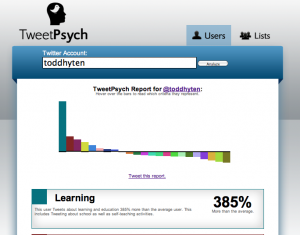I believe it was a tweet by Trey Pennington that alerted me to this very cool new tool for Twitter called TweetPsych by HubSpot’s Dan Zarrella. All you have to do is put in your Twitter handle and you instantly get a report that measures how far above or below the norm your tweets are for certain word-related criteria such as: emotions, thinking, control, positive, negative, self-reference, sex, time, education, learning, etc.
 What you end up with (see thumbnail) is a graph that tells you where your tweets fall, above or below the norm for these criteria. Try to map the results to the goals of your own tweets. It’s great for noting deficiencies, so you know what areas to work on.
What you end up with (see thumbnail) is a graph that tells you where your tweets fall, above or below the norm for these criteria. Try to map the results to the goals of your own tweets. It’s great for noting deficiencies, so you know what areas to work on.
For instance, about one-third of my profile is above the average; the rest of the traits are below — but this isn’t necessarily bad news. I do need more “above the norms” though – at least in some areas.
For example, my Twitter account is 385% above the norm for learning. Which closely matches my goal as a consultant. I love passing on as much interesting info I can about inbound marketing and web marketing in general. I’m also in high double digits above the norm for mentions that are: constructive, work (related), conceptual, numbers (oriented), and thinking. That’s great — pretty much what I’m shooting for.
Apparently I’m below the norm for mentions of sex – by 22%. When I read that I laughed and thought (only 22%)? I’m just 15% below average for mention of social activities, and a whopping 65% below average for self-references. I’m also 25% below average for “positive” themes, but I’m not so surprised about that if I’m writing about marketing (it’s not all sunshine and pixie dust folks, sorry).
The point is, now I have some guide on what areas to work on for my tweets.
Very cool.